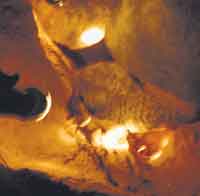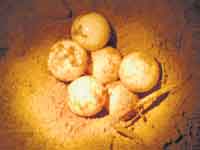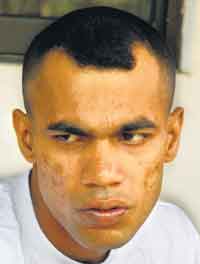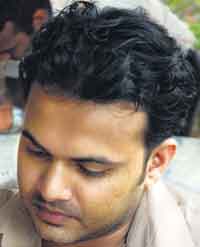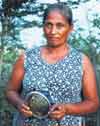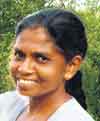|
|
||||||||||||||
Turtle territory On a moonlit night, around ten, we are spread-eagled on the beach, peering by the single beam of a torch at the wonder of life unfolding before our very eyes. Looking at the rear of a large Green turtle, what do we see? The short, pointed triangular tail lifts suddenly, the back muscles contract, a liquid squirts out, followed soon after by white golf ball-like eggs in quick succession. “The liquid is anti-bacterial and helps protect the eggs,” a knowledgeable Nuwan Menaka, 23, whispers.
Slowly and skilfully, Thushara Weerawarana, 27, slips his hand under the flank of the turtle, which is oblivious to this friendly intrusion and gently ferrets out ten eggs. Then Nuwan and Thushara weigh and measure the eggs, recording each detail, all by torchlight, and surreptitiously slip them back into the flask-like nest. Earlier we had walked awhile, observing the long stretch of beach in Rekawa, awash in silvery moonlight giving it an almost ethereal quality. Here and there, the spotless beach is marked by caterpillar like tracks, indicating the point at which the lumbering female turtles have come ashore to nest. From being a turtle hunting ground, not only for eggs, but also for the meat, Rekawa, has turned turtle, not only protecting these endangered creatures, but also becoming eco-friendly. The five species of turtles, which regularly nest here, were not nature’s only bounty that was under attack in this scenic village earlier. Most of the villagers were either engaged in collecting turtle eggs as soon as they were laid, slaughtering turtles for their meat, breaking corals for the lime kilns in the area or cutting down the mangroves to fire the kilns. Rekawa’s women divers were well known for their coral breaking and collecting ability, and until recently believed that it was the only livelihood they could engage in, handed down by their mothers and grandmothers. (See box) “Those days we used to lie in wait for the turtles to emerge from the sea, lay their eggs and collect them immediately. One turtle lays about 120-150 eggs,” says Thushara, now turned nest protector.
How did the villagers divide the wide open beach and mark their territories? “We walked the beach alone, and whoever saw the turtle first was the keeper of the eggs for sale,” explains Thushara, who knew no other life but this, as he had lost his father when he was just a boy, leaving no one to fend for the family. “Belle wela dagaththa,” he says sadly, explaining that his father hanged himself. The family troubles and hardship were so heavy that he failed his O/Levels and resorted to selling turtle eggs, while his other siblings and even his mother salvaged the floating pieces of coral. Called upon by chance to do a survey along the coastal belt on turtle nesting areas, a group of youth who passed through Rekawa way back in 1993 made it their mission to convert the village. Banding themselves as the Turtle Conservation Project (TCP), headed by Thushan Kapurusinghe, they paid many visits to Rekawa, and slowly but surely made the villagers aware that they were in fact killing the goose that was laying the golden eggs, of course, in a turtle context.
“We were made to know the gravity of the situation, if we continued to retain our livelihood,” says villager Thushara, going into detail on how the turtles would become extinct and then the foreigners who come to see them would stop. Now the signs of conversion albeit with regard to being eco-friendly are visible. Getting paid a small allowance from the TCP, which gets funding for their work from UNDP, until turtle-watching in Rekawa catches on as part of the tourist trade, Thushara guides the tourists, both local and foreign. “We do not allow them to use camera flashes, because the turtles get briefly blinded by the flash,” he says, adding that he and the others also explain to them about turtle conservation, in a cadjan hut on the beach by the light of a lamp. “We don’t allow people to drink alcohol or litter the beach. We also don’t allow anyone, even the villagers to take the eggs.”
Hopefully tourism should rise with the decision to declare Rekawa as the first wildlife sanctuary for reptiles in Sri Lanka. Research officer Nuwan of the TCP says they keep an eye on the nests, safeguarding both the eggs and the young from such predators as dogs, kabarayas, crows and a certain type of ant. Once the eggs hatch and the baby turtles have scrambled to the sea, they check out the empty nests. “We count how many disabled babies are left, and how many eggs there are without the yolks, and record it all.” Adds TCP head Thushan, “This is in-situ conservation of turtles. Researchers from the TCP and villagers keep vigil each night and check out the turtles, tag them, if they have not been tagged, so that they can be identified, and also mark the nests by identifying two natural elements like trees or rocks for better protection.” Thushan, however, feels it is still not enough. “We have started a small-scale batik and coir industry for the women, in addition to the men becoming turtle-nest protectors. The women make colourful batiks with turtles as the theme and floor mats in the shape of turtles. But more needs to be done.”
|
||||||||||||||
Copyright © 2006 Wijeya Newspapers
Ltd. All rights reserved. |
